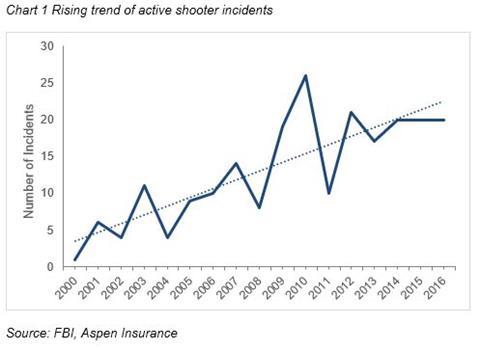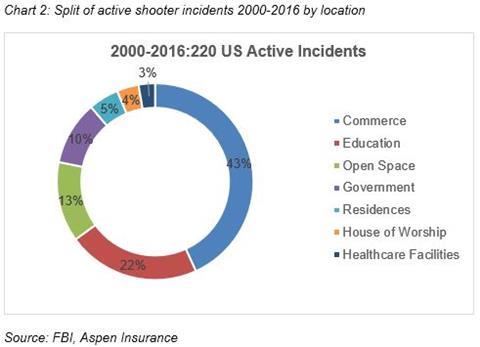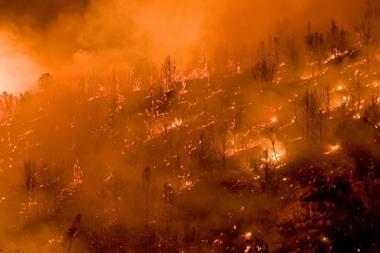Henry MacHale, global head of crisis management at Aspen Insurance, reflects on the growing incidence of active shooter and “lone wolf” terrorist attacks

Henry MacHale (pictured), global head of crisis management at Aspen Insurance, reflects on the growing incidence of active shooter and “lone wolf” terrorist attacks. The perpetrator of such crimes may be motivated by a varying degree of personal and political grievance but it is clear that the goal is to inflict large-scale loss of life. Most businesses and organisations cannot rule out attack given that there are limited patterns to the selection of victims, but specialist risk management can help prepare for and assist in the effective management of such an eventuality and help to reduce the devastation and disruption.
The Las Vegas shooting in October 2017 was the worst incident of mass-murder in the US since 9/11. The killings were conducted by a sole gunman who fired over 1,100 rounds of ammunition from a 32 storey hotel window. His motivation was unclear but the attack resulted in 58 fatalities and 546 injuries. Such incidents, where victim selection is random, appear to be on a rising trend.

The perpetrator of such events has been described by The US Department of Homeland Security as an “active shooter” (an individual actively engaged in killing or attempting to kill people in a confined and populated space where, in many cases, there is no pattern or method to their selection of victims). In many incidents, the shooter does not have any apparent connection with the location of the attack.
Chart 1 demonstrates the increasing occurrence of active shooter incidents, while data from the Gun Violence Archive shows a rising trend of numbers of individuals injured or killed in ‘mass incidents’ (where four or more people are shot).
Active shooters are difficult to detect and can slip under the security services radar. Their motives may be predicated by a mix of personal and political grievances, mental health issues and societal alienation and, as such, are not easily detected.
This method of attack has been courted by terrorist organisations, such as Al Qaeda and ISIS, as a more effective conduit to cause disruption and fear. The incitement of jihadist sympathisers in the West has included practical guidance for lone wolf attacks, including descriptions and advice on how to maximise impact and victims.
Indeed, the conventional terrorist of the 1990s who attacked physical property with larger scale explosives has been largely replaced with the terrorist targeting human capital.
Table 1 lists a number of recent attacks. There are limited patterns to the location and targeting of victims but the central theme connecting all events is the intent to kill.
Table 1: Recent selected terror attacks
| Date | Location | Attack method | Fatalities | Injured |
|---|---|---|---|---|
|
January 2015 |
Paris, France |
Small Arms |
12 |
22 |
|
June 2016 |
Orlando, USA |
Small Arms |
50 |
58 |
|
August 2016 |
Nice, France |
Truck, small arms |
86 |
434 |
|
December 2016 |
Berlin, Germany |
Truck, small arms, knife |
12 |
56 |
|
March 2017 |
Westminster, UK |
Van, knife |
6 |
49 |
|
June 2017 |
Southwark, UK |
Van, knife |
8 |
48 |
|
June 2017 |
Finsbury Park, UK |
Van |
1 |
8 |
|
August 2017 |
Barcelona , Spain |
Van |
13 |
100 |
|
October 2017 |
Las Vegas, USA |
Small Arms |
58 |
547 |
|
October 2017 |
Manhattan, USA |
Van |
8 |
11 |
Source: Aspen Insurance
Small arms are the weapon of choice although vehicles and knives have also been used to considerable effect. The increasing use of small arms has been mirrored by a decline in the use of large scale explosives.

In the US, legislation concerning incendiary devices has played a part in shaping this trend as licencing and permission requirements of manufacturers, dealers and users have been strengthened. More stringent controls have also been introduced on the sale and transfer of explosive materials.
Meanwhile, small arms laws have arguably been relaxed with the non-renewal of the federal ban on the manufacture and possession of semi-automatic assault weapons and large capacity magazines. Manufacturers and dealers have broad immunity from civil lawsuits and the FBI is required to destroy all approved small arms purchaser records within 24 hours. Meanwhile, gun manufacture in the US has increased from 2.9m per annum in 2001 to 9.4m in 2015.
The intent to inflict as much harm as possible has meant that most locations are not beyond the risk of attack, and casualties can include employees, customers, security and law enforcement alike. Chart 2 shows that commercial premises are the most common location for attack followed by educational establishments. In short, few businesses or organisations can rule out the possibility of an attack.
Prevention and preparation
The US Department of Homeland Security has published a guide on how to respond to an active shooter incident. This emphasises the importance of formulating an Emergency Action Plan (EAP) with input from a range of stakeholders, including human resources, facility operators, security and law enforcement.
Individuals should be prepared both mentally and physically given that the duration of shooter incidents can often be short and conclude before law enforcement has arrived on the premises. Staff training is key so that that they can recognise a threat; follow the recommended run, hide, fight course of action; call the emergency services and be prepared to react to a law enforcement plan of action.
Insurance is about risk management through prevention and financial damage limitation. A hybrid approach to coverage - that combines protection for the human element, as well as property damage and business interruption coverage - is likely to yield a more responsive result. The attacker is looking to maximise devastation and disruption through loss of life. Those surviving the ordeal may be badly injured (physically and or psychologically) and require lengthy rehabilitation programmes. Relatives of those killed in an incident will be concerned with any possible evidence of negligence and demand an audited document to prove that all reasonable security precautions had been taken.
The insured will likely face business interruption challenges as the scene of the crime is investigated by security services, the outcome of which may endanger brand reputation. The response plan can play an instrumental role in how an organisation is perceived and subsequent damage to brand. It will also have a bearing on the length of time an organisation is closed for business, reflecting the adequacy of security measures and/or staff recovery time.
As a result, preparation and prevention through the instigation of risk assessment, and implementation of comprehensive cover - not just for property damage but also business interruption, rehabilitation and crisis management services - provides a greater degree of assurance to meet the far-reaching costs of an attack.




















No comments yet